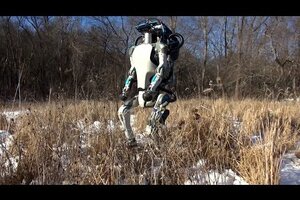How bullying a 180-pound robot could help improve disaster response
The newest generation of Atlas shows off some defensive skills in a video released Wednesday by Boston Dynamics. Why learning to deal with meddling humans could help rescue crews.

A new version of Atlas, designed to operate outdoors and inside buildings. It is specialized for mobile manipulation. It is electrically powered and hydraulically actuated. It uses sensors in its body and legs to balance and LIDAR and stereo sensors in its head to avoid obstacles, assess the terrain, help with navigation and manipulate objects. This version of Atlas is about 5' 9" tall (about a head shorter than the DRC Atlas) and weighs 180 lbs.
If robots ever seek revenge on humans, they’ll likely use this three-minute YouTube video released by Boston Dynamics Wednesday as propaganda.
Boston Dynamics, a Google-owned company that began as a spin-off from the Massachusetts Institute of Technology, has engineered a number of robot prototypes since its inception in 1992.
But as the video shows, the latest generation of Atlas may be the most impressive yet. At 5’9” and 180 pounds, Boston Dynamics newest ‘bot is much more human-like than its previous 6’, 330 pound predecessor. The robot uses stereo sensors and Lidar technology to navigate, finding and picking up ten-pound boxes even when a human bully pushes them out of its way.
In this case at least, all the school yard bullying is for a good cause. The US military one day hopes to deploy Atlas's decedents into disaster situations where human rescue teams may have difficulty finding access, like the 2001 Fukushima Daiichi nuclear disaster. For that to become a reality, rescue robots will need some human-like skills.
In the video released on Tuesday, Atlas shows of some human-like balance and stability. After a human shoves it with a hockey stick, Atlas regains its balance by running backwards and then re-attempting to pick up the box. Atlas is also able to stand-up on its own after falling face-first on the floor, thanks to a hockey stick shove to the back by its human nemesis.
Most notably, the newest Atlas robot is battery powered.
“Perhaps the most important change this time round is the lack of cables and support tethers,” explains Forbes contributor Brid-Aine Parnell. “This frees Atlas up for all kinds of uses, including search and rescue operations in areas humans can’t enter and basically any outdoor work.”
Boston Dynamics created the first generation of Atlas for the Defense Advanced Research Projects Agency (DARPA) Robotics Challenge in 2013. In this prize competition, engineers showcase their robot creations with the goal to “assist humans in responding to future natural and man-made disasters.” During the challenge, the teams “guide the robots through a series of physical tasks representative of what might be encountered in disaster zones.”
In 2013, DARPA named Atlas one of the most advanced robots ever built. But Atlas came in second place because the judges wished to see better durability and power efficiency: requests that seem fulfilled in Boston Dynamics’ new video.
To those in the robot world, Boston Dynamics’ newest prototype is groundbreaking and exciting. But the everyday viewer can’t help but feel sorry for the bullied robot after watching the YouTube video.
“It definitely triggered the uncanny valley response,” Ken Goldberg, robotics professor at the University of California, Berkeley, tells Wired. “I mean, most of us probably had the same reaction when it got pushed around: We expected it to turn around and blast that guy with a laser beam.”
But Goldberg tells Wired that the physical bullying is what makes the video so impressive.
“When something sudden and fairly impactful happens to the robot, we call that an impulse, and that’s very difficult for a system to respond to,” explains Goldberg.

